Search Results
The Beatles “Rarities”, Parlophone PSLP 261.
Release December 15, 1978. Originally included as a free addition to the 1978 boxed set, The Beatles Collection (blue box). Only rare tracks are “Across The Univers”, previously available only on the now-deleted charity album No One’s Gonna Change Our World, and the German-language version of “She Loves You” and “I Want To Hold Your Hand”, previously unavailable in Britain. In fact eight of the 17 tracks were previously available: “Long Tall Sally”, “I Call Your Name”, “Slow Down”, “Matchbox” and “I’m Down” are on the Rock And Roll Music album; “Yes It Is” and “This Boy” on Love Songs; and “Rain” on the Hey Jude album. Only four of the 17 tracks “Across The Universe”, “Komm, Gib Mir Deine Hand”, “Sie Liebt Dich”, and “Bad Boy”, are in stereo. Although the album contains very little in the way of rare tracks, it is an intelligent compilation of some of the material previously available only B sides, EPs and foreign releases.
All free additions have a dark blue sleeves with gold text on both sides. Besides the sleeve has the banner “Sampler Album Not For Sale” in the upper left corner on the back and catalog number PSLP 261. All additions have white paper EMI custom inner sleeves.
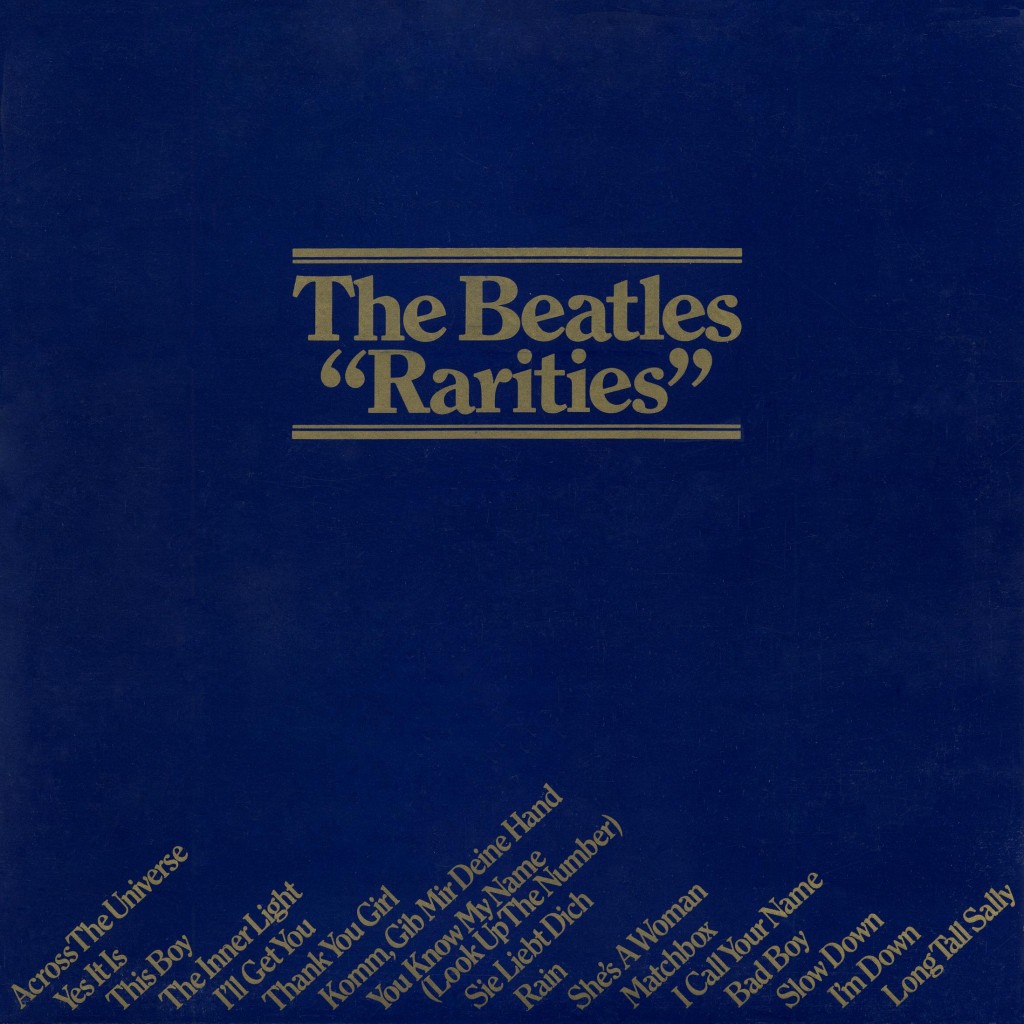
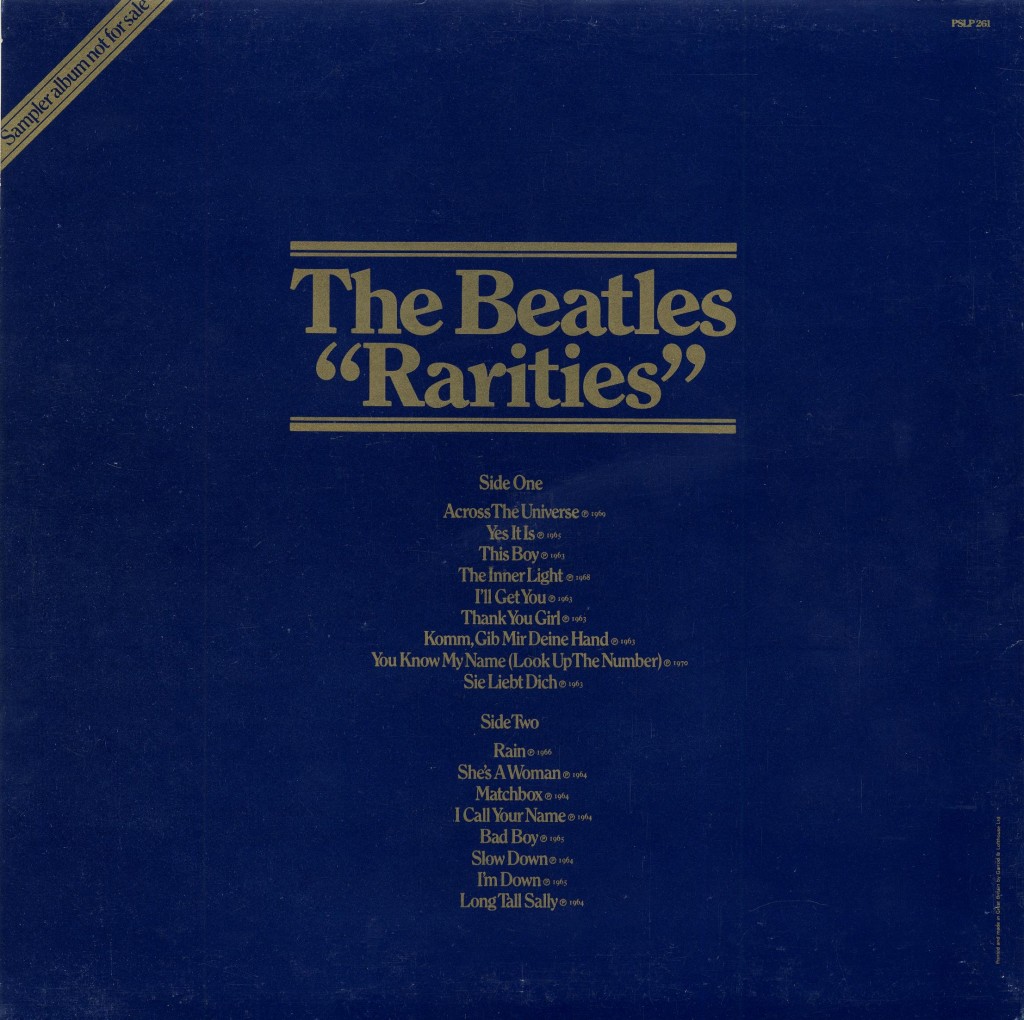
1. First pressing December 15, 1978. Black label with two white-black EMI logos and silver print. “The EMI Records Ltd” printed at the start perimeter print and “Made In GT. Britain” printed at the end of the perimeter print. Matrix numbers: Side One: SPSLP 261 A-1, Side Two: SPSLP 261 B-2.
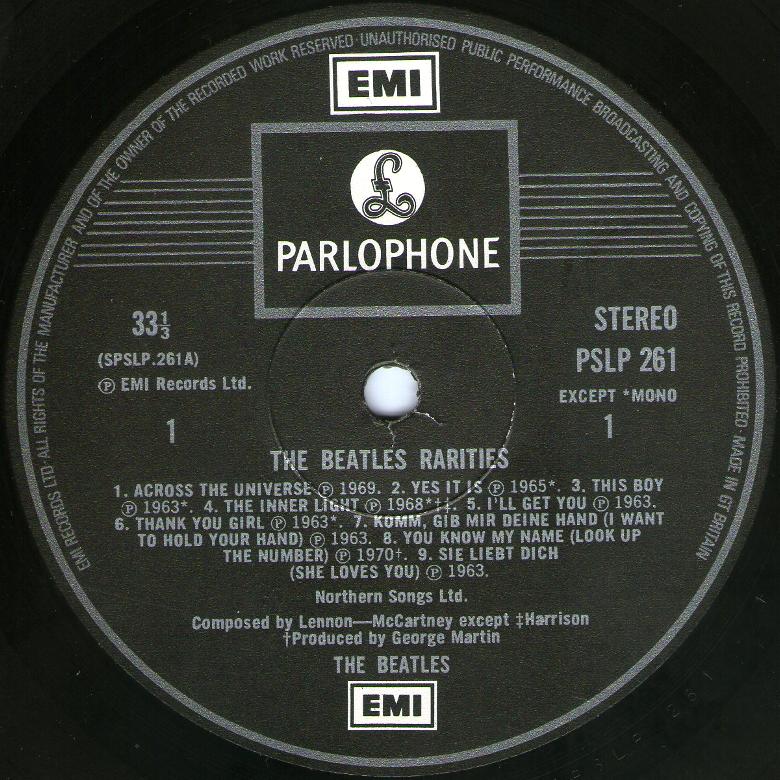
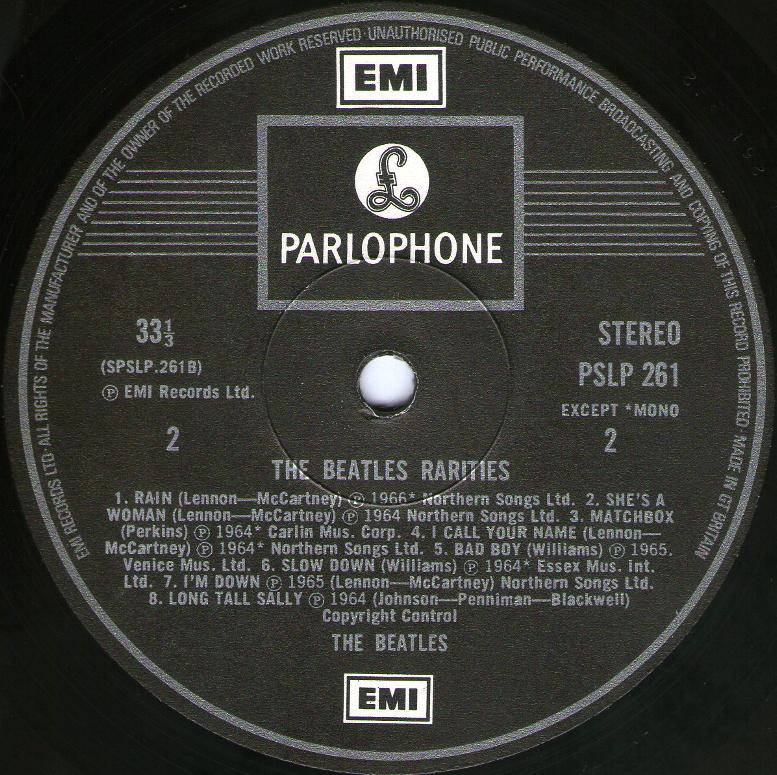
In 1978, EMI and some of its worldwide subsidiaries, including Capitol Records, issued The Beatles Collection box set. While Capitol imported the Parlophone and Apple catalog albums placed in the box set, it chose to manufacture the bonus disc, assigning it promotional number SPRO-8969. This version of the Rarities album is similar to the EMI edition; however, Capitol replaced the German-language versions of “I Want To Hold Your Hand” and “She Lovea You” found on the British standard versions. In all likelihood, the switch was made because Capitol wanted the collection to include the standard English versions of these huge hits, which were not on any of the British albums included in the box set.
The Capitol Rarities disc was manufactured with purple labels featuring the classic Capitol dome logo. It was packaged in a dark blue paper sleeve. The front side has “The Beatles “Rarities” centered and the Capitol logo and SPRO-8969 in the lower right corner. The back side is solid blue. In addition to placing the album in the box set, Capitol pressed 2,000 copies of Rarities for promotional purposes. Matrix numbers: Side One: SPRO-1-8969 F1, Side Two: SPRO-2-8969 F1.
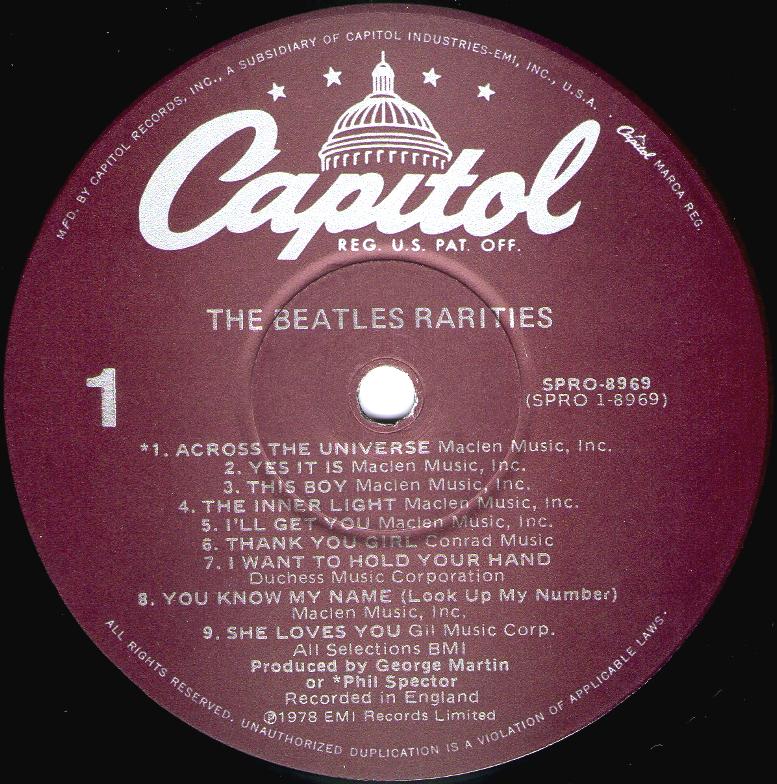
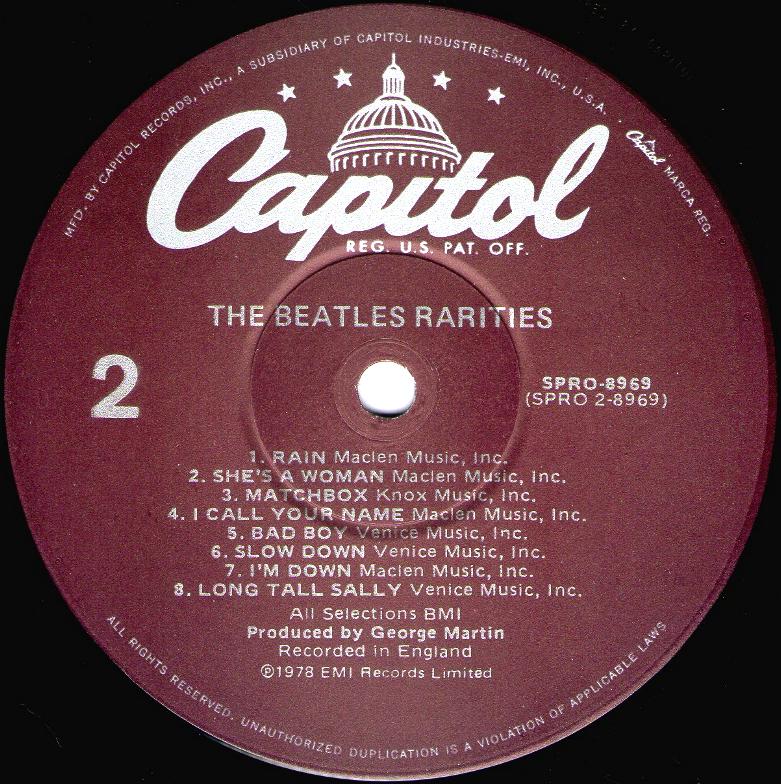
2. Second pressing October 1980 until April 1984. Black label with two white-black EMI logos and silver print. “ALL RIGHTS OF THE PRODUCER” printed at the start perimeter print. Importantly, around the 11 o’clock position in the rimtext the wording is: “UNAUTHORISED PUBLIC PERFORMANCE, BROADCASTING, COPYING AND HIRING”. Instead, added “MANUFACTURED IN THE UK BY EMI RECORDS LIMITED” text at the end of the perimeter print. Matrix numbers: Side One: SPSLP 261 A-1 or -2, Side Two: SPSLP 261 B-2 or -3.
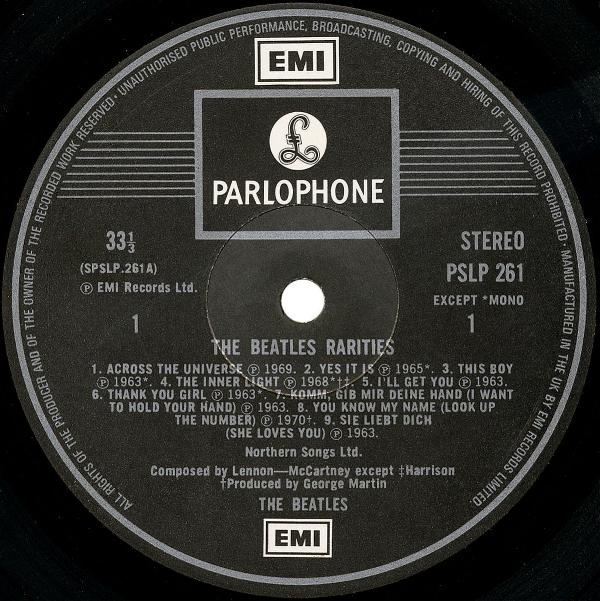
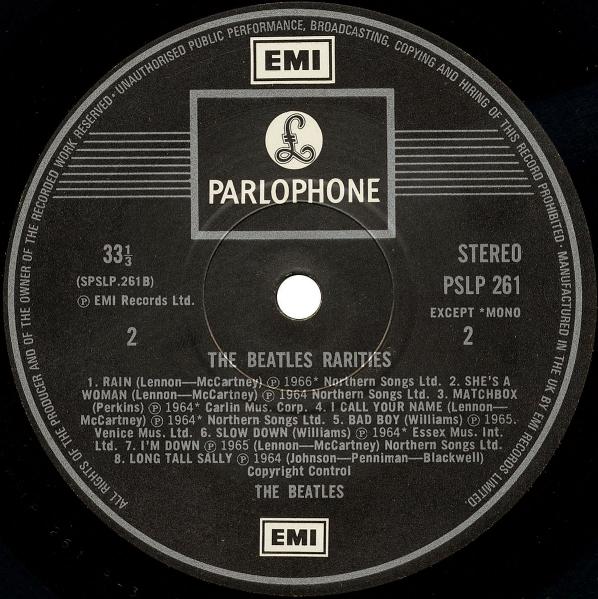
3. Third pressing, end of spring 1984 until 1987. Black label with two white-black EMI logos and silver print. “ALL RIGHTS OF THE PRODUCER” printed at the start perimeter print. Importantly, around the 11 o’clock position in the rimtext the wording is: “UNAUTHORISED COPYIN, HIRING, RENTING, PUBLIC PERFORMANCE AND BROADCASTING”. “MANUFACTURED IN THE UK BY EMI RECORDS LIMITED” text at the end of the perimeter print. Matrix numbers: Side One: SPSLP 261 A-2, Side Two: SPSLP 261 B-3 or -4.
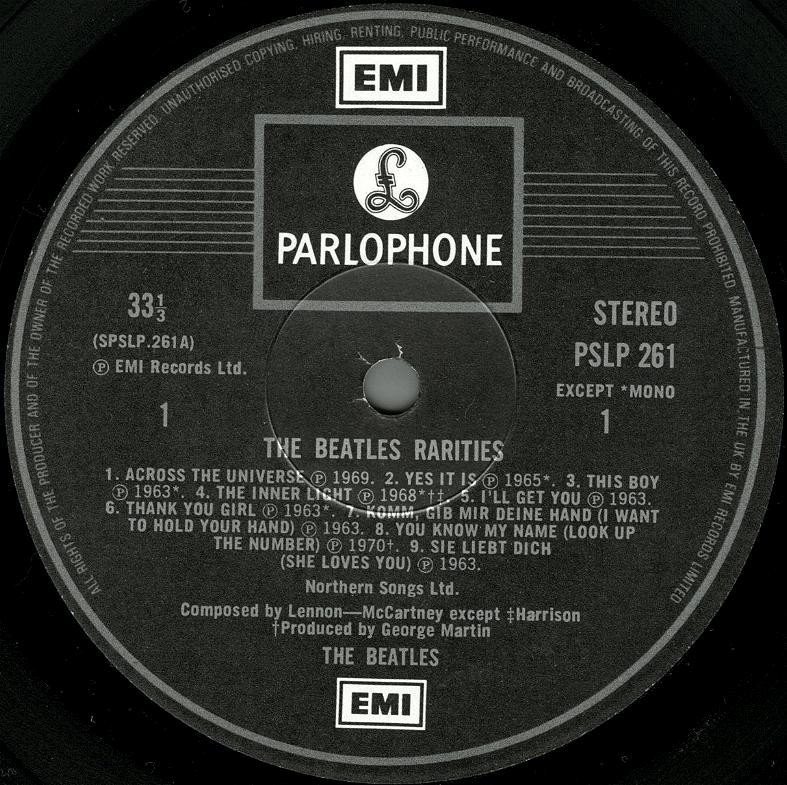
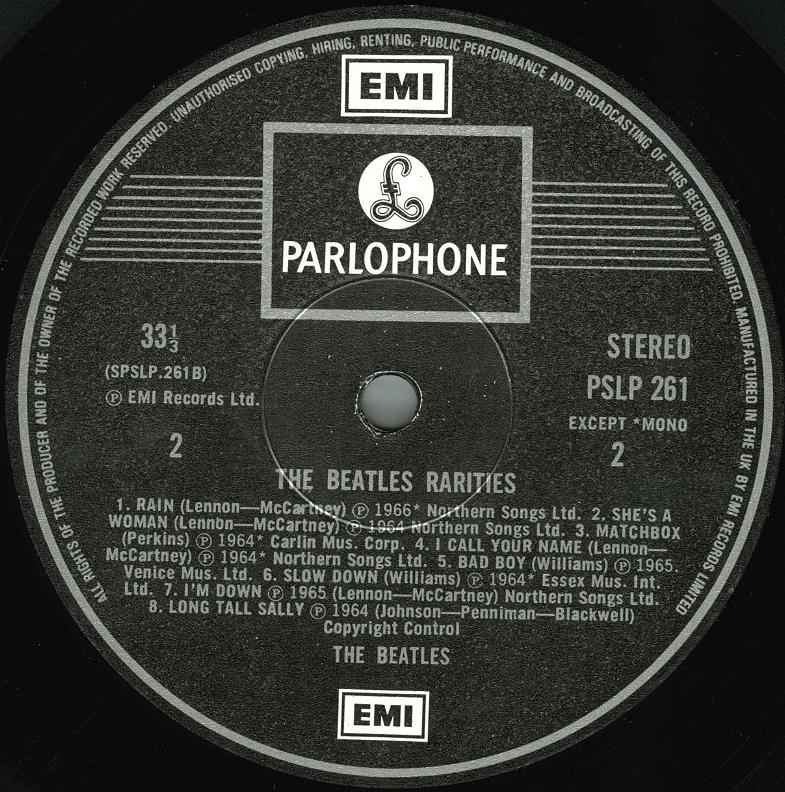
The Beatles “Rarities”, Parlophone PCM 1001.
Release October 29, 1979. This album was issued separately in 1979 after EMI had received complaints that the only way of obtaining this free album was to pay for the box and its duplicate copies of Beatles albums. The album has a dark blue sleeve with big note on the back side and catalog number PCM 1001. All editions have white paper EMI custom inner sleeves.
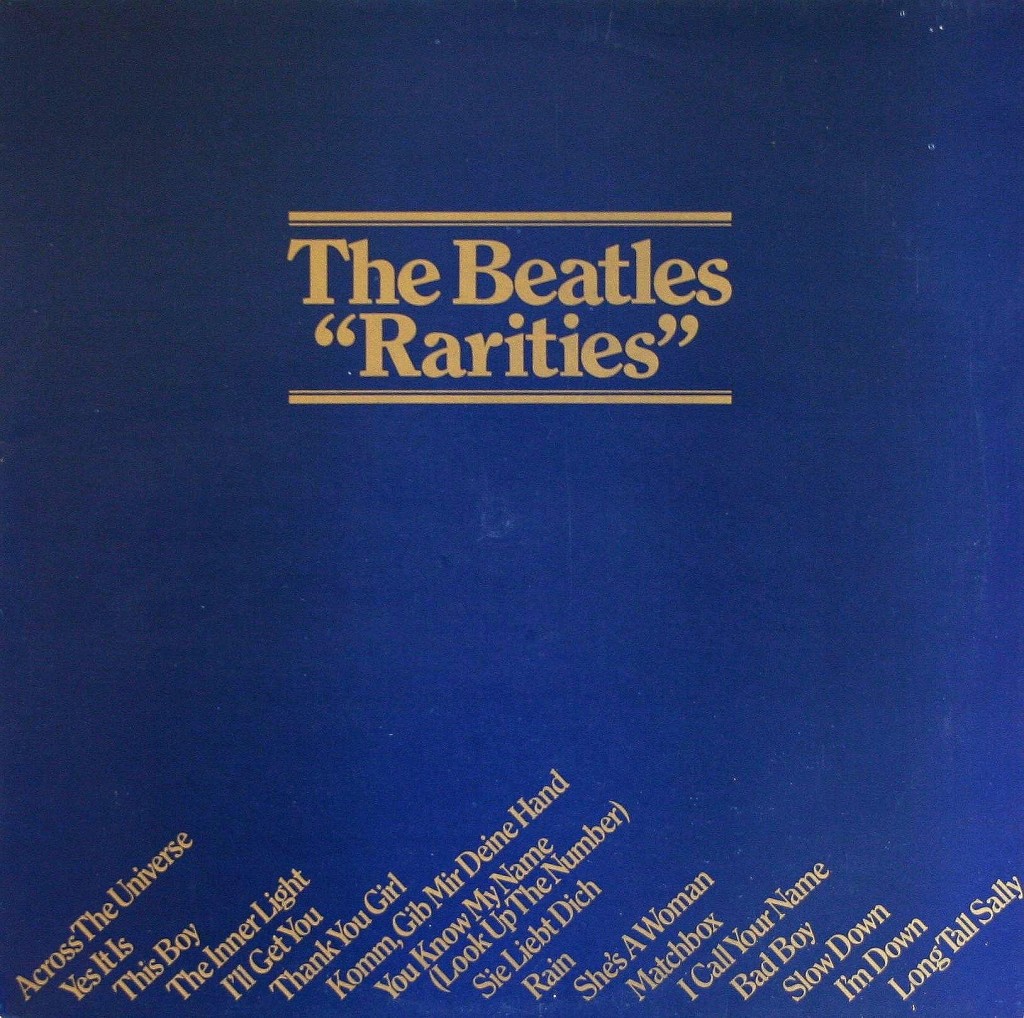
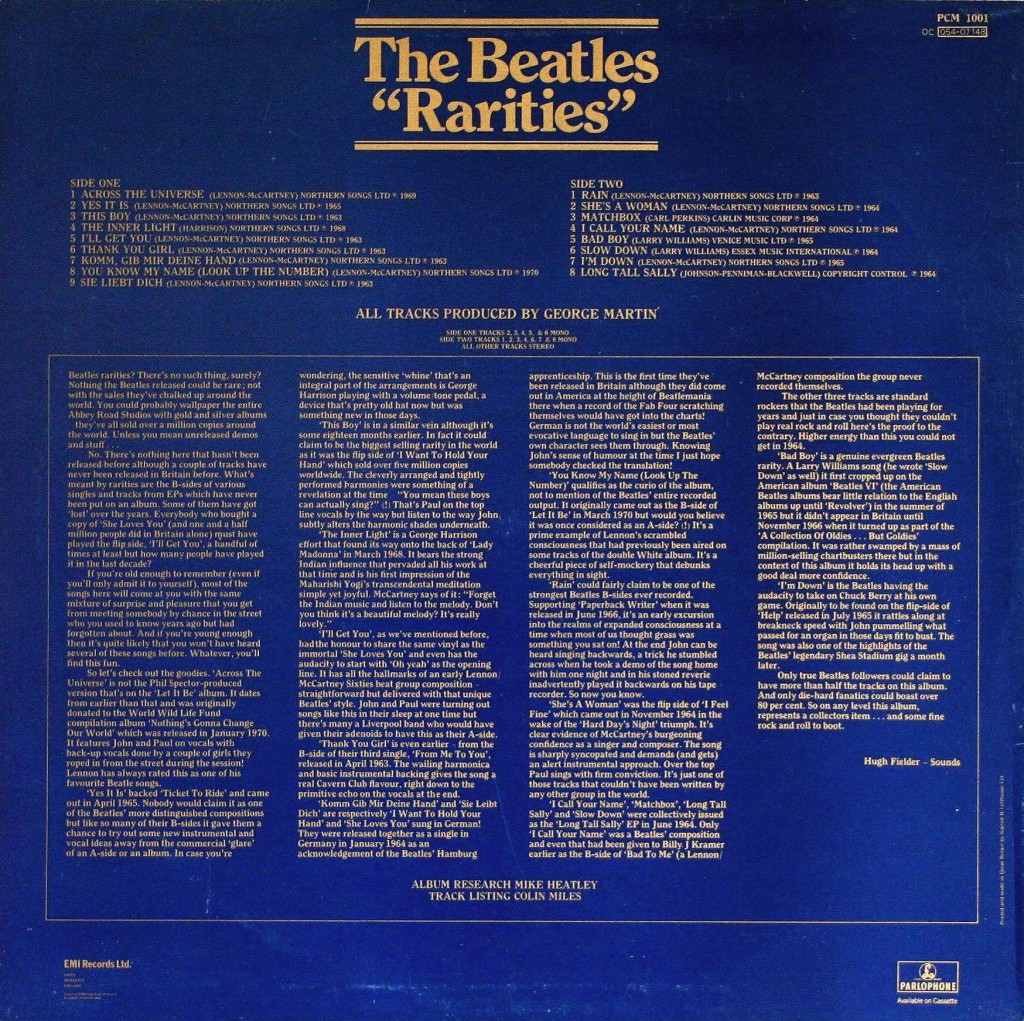
1. First pressing October 29, 1979. Black label with two white-black EMI logos and silver print. “The EMI Records Ltd” printed at the start perimeter print and “Made In GT. Britain” printed at the end of the perimeter print. Matrix numbers: Side One: SPSLP 261 A-1 YEX 991-1, Side Two: SPSLP 261 B-2 YEX 992-2.
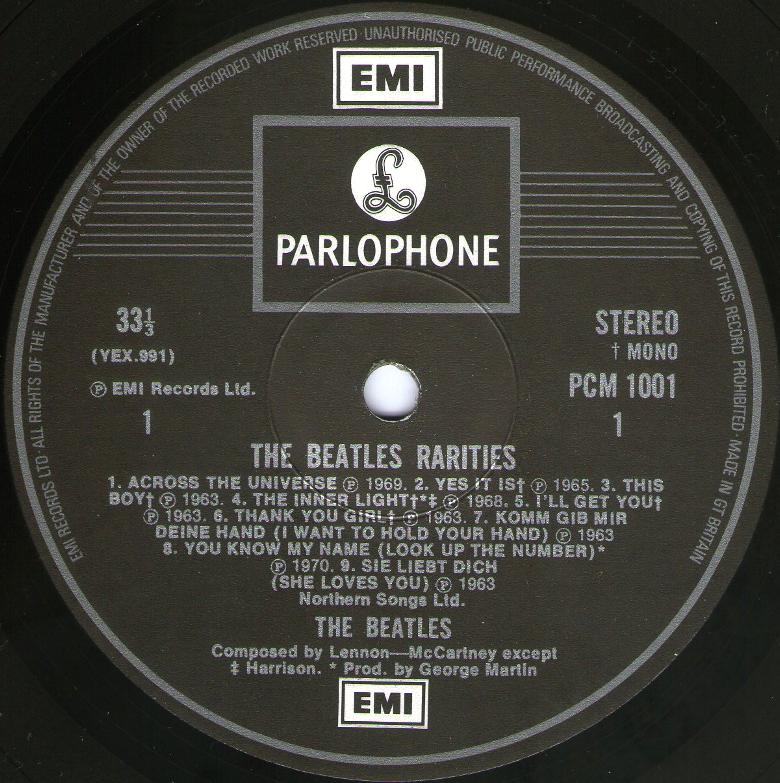
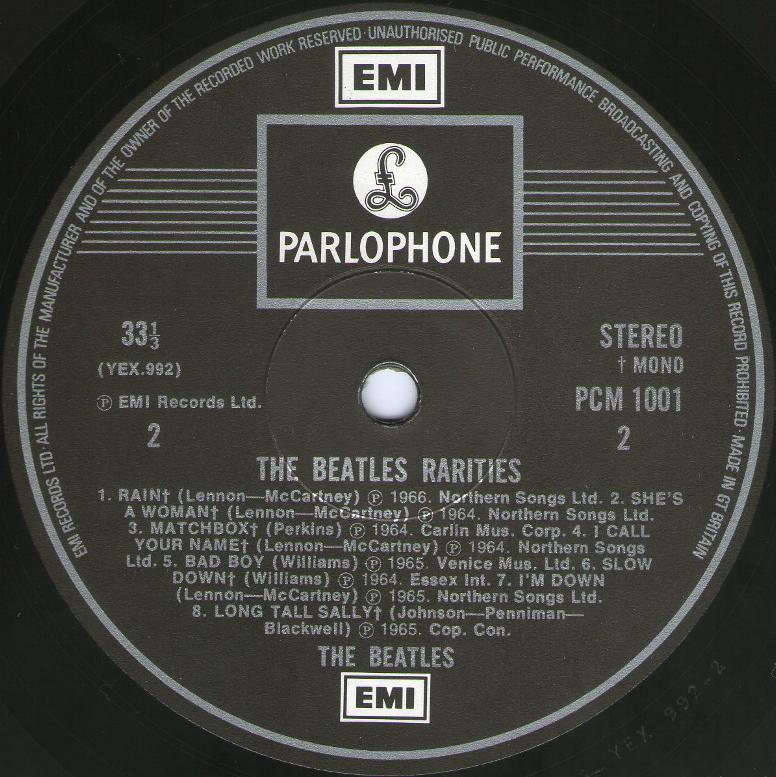
2. Second pressing October 1980 until April 1984. Black label with two white-black EMI logos and silver print. “ALL RIGHTS OF THE PRODUCER” printed at the start perimeter print. Importantly, around the 11 o’clock position in the rimtext the wording is: “UNAUTHORISED PUBLIC PERFORMANCE, BROADCASTING, COPYING AND HIRING”. Instead, added “MANUFACTURED IN THE UK BY EMI RECORDS LIMITED” text at the end of the perimeter print. Matrix numbers: Side One: YEX 991-2 or -3, Side Two: YEX 992-3 or -4.

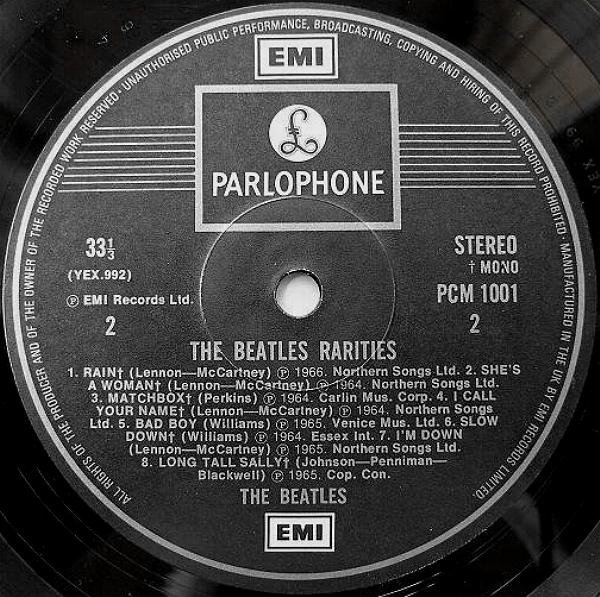
Released March 7, 1988. The first record contains the original version of “Love Me Do” with Ringo on drums, together with both the A and B sides of a further four singles “From Me To You”, “She Loves You”, “I Want To Hold Your Hand” and “I Feel Fine”, together with their respective B sides of “Thank You Girl”, “I’ll Get You”, “This Boy” and “She’s A Woman”. Other tracks on the Record One are “Komm, Gib Mir Deine Hand” and “Sie Liebt Dich” originally issued in Germany as single. “Long Tall Sally” and “I Gall Your Name” were originally part of the 1964 American “The Beatles’ Second Album”. These, together with “Slow Down” and “Matchbox”, were later issued in Britain on EP. “Bad Boy” originates from the American album “Beatles VI” and was later to be included on the British album “A Collection Of Beatles Oldies”. Finally are included “Yes It Is” and “I’m Down”, that were the B sides of “Ticket To Ride” and “Help!” respectively and were included on the “Help!” album. The version of “This Boy” is the true stereo version originally available only on singles issued in Australia (Parlophone A8103) and Canada (Capitol 72144), and it makes its first appearance on an album here. “She’s A Woman” again in stereo, originates from the 1967 Australian album “Greatest Hits Volume 2” (Parlophone PCSO 7534). “Yes It Is”, in stereo, was issued in Britain in 1986 as part of the “Only Beatles” cassette (Parlophone SMMC 151). Finally, “I’m Down”, in stereo, originally was issued as part of the Japanese “Help!” EP (Odeon EAS 30006). With the exception of “I’m Down”, these stereo versions have been given their first international release on this album.
The Record Two contains “Paperback Writer” that together with “Rain” was issued as a single in june 1966, “The Inner Light”, the B side to the March 1968 single “Lady Madonna”, “Revolution” that was the upside of The Beatles’ first Apple single “Hey Jude” in August 1968, and, finally, “You Know My Name” the B side to their final single “Let It Be” in March 1970.”Across The Universe” originally was included on the charity album “No One’s Gonna Change Our World” issued in 1969.
1. First pressing, March 7, 1988. Unlaminated gatefold black & white outer sleeve with Parlophone logo on the back side. Records are housed in white plain paper inner sleeves.
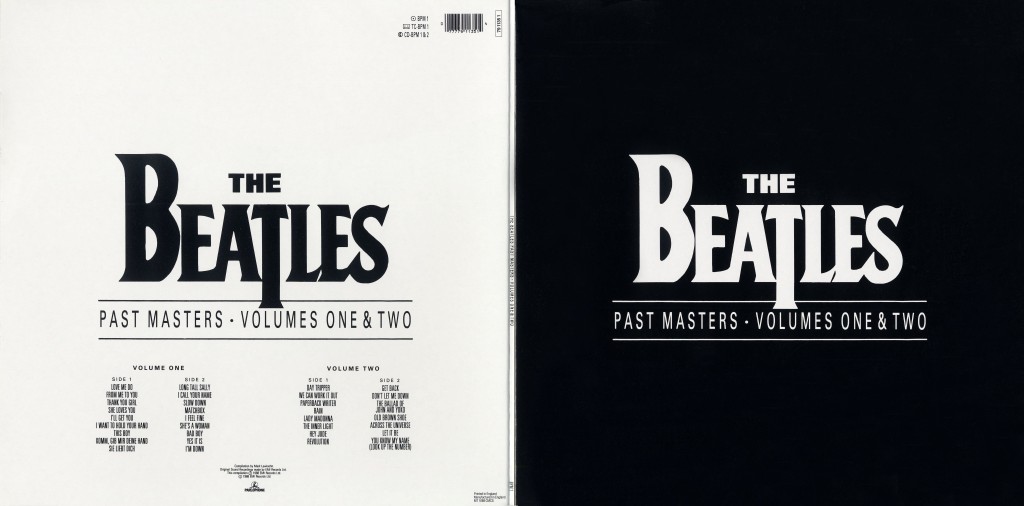
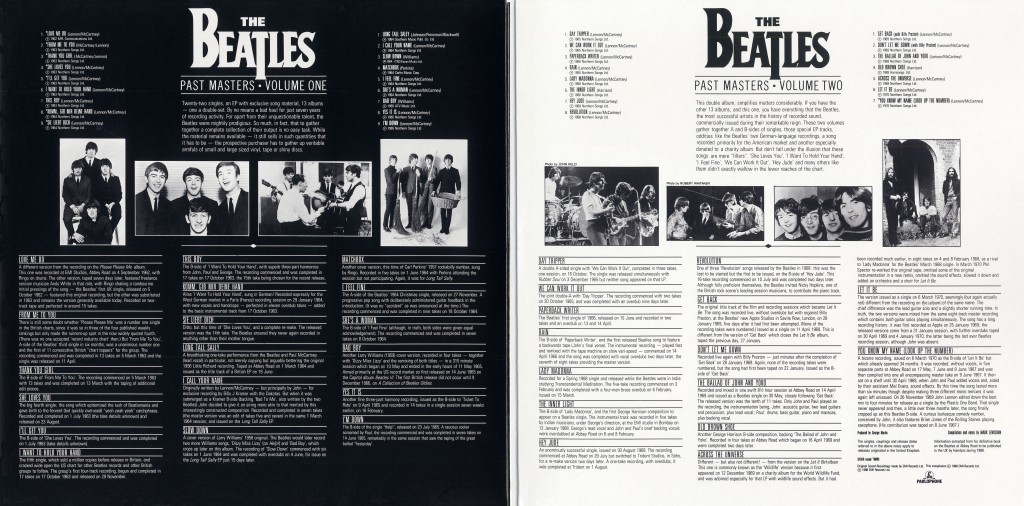
Black label with silver Parlophone logo and silver print. “ALL RIGHTS OF THE PRODUCER” printed at the start perimeter print. Importantly, around the 11 o’clock position in the rimtext the wording is (right to left): “UNAUTHORISED COPYING, HIRING, RENTING, PUBLIC PERFORMANCE AND BROADCASTING”. “MANUFACTURED IN THE UK BY EMI RECORDS” text at the end of the perimeter print. First matrix numbers have the error prefix of the catalog numbers BTM which were scratched out: Record One – Side 1: BPM BTM 11 A-1-1-1; Side 2 BPM BTM 11 B-1-1-1 (or 2); Record 2 – Side 1: BPM BTM 12 A-1-1-1; Side 2 BPM BTM 12 B-1-1-1.




2. Second pressing, 1990s. The gatefold outer sleeve is characterized by the presence of the Apple logo on the back side. Records are housed in white plain paper inner sleeves.
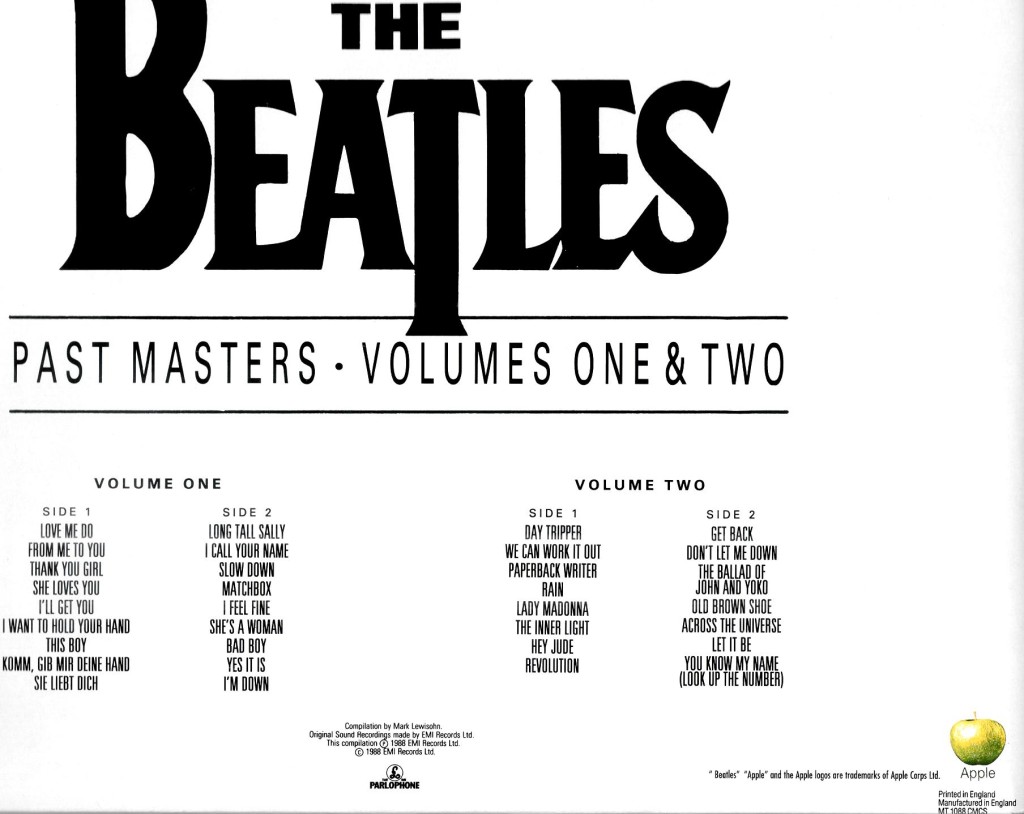
The second pressing has labels as the first pressing. Matrix numbers: Record One – Side 1: BPM 11 A-02-01-1; Side 2 BPMBTM 12 A-1-1-2; Side 2 BPM
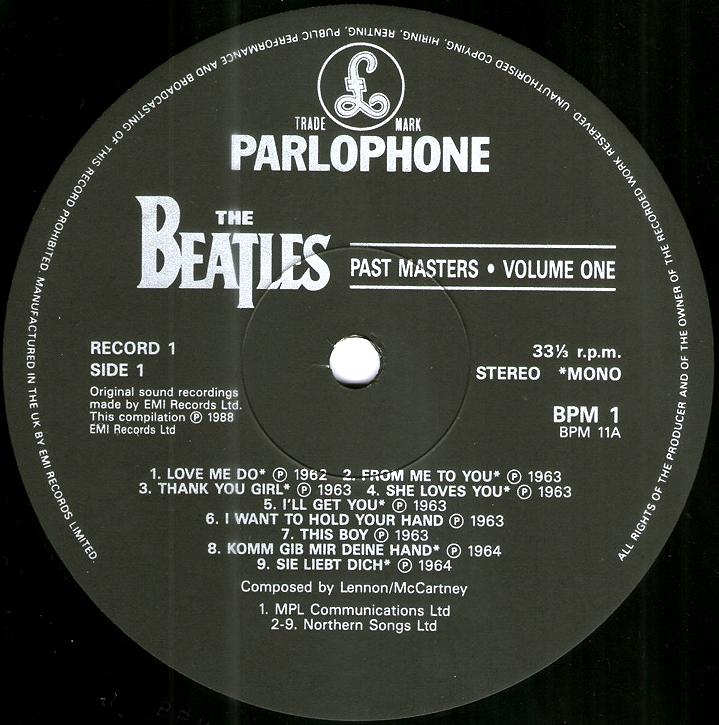
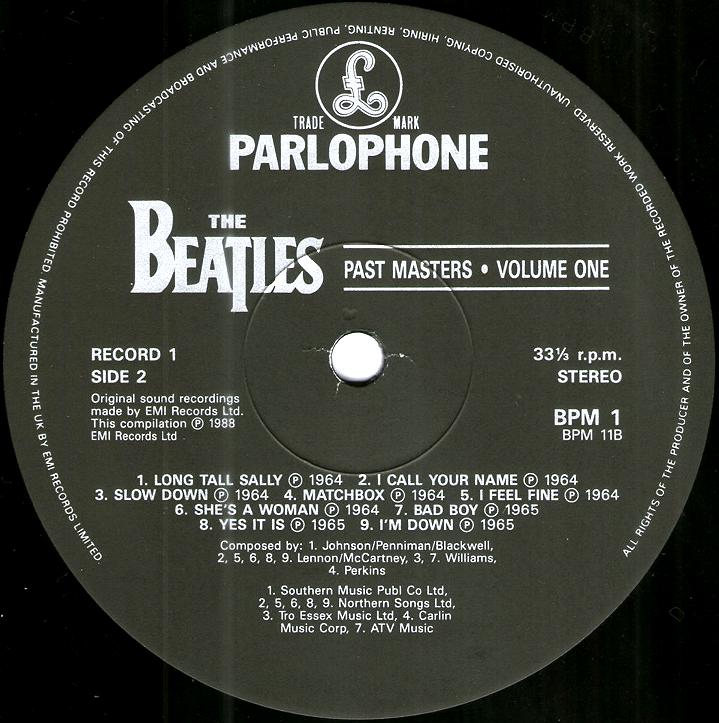
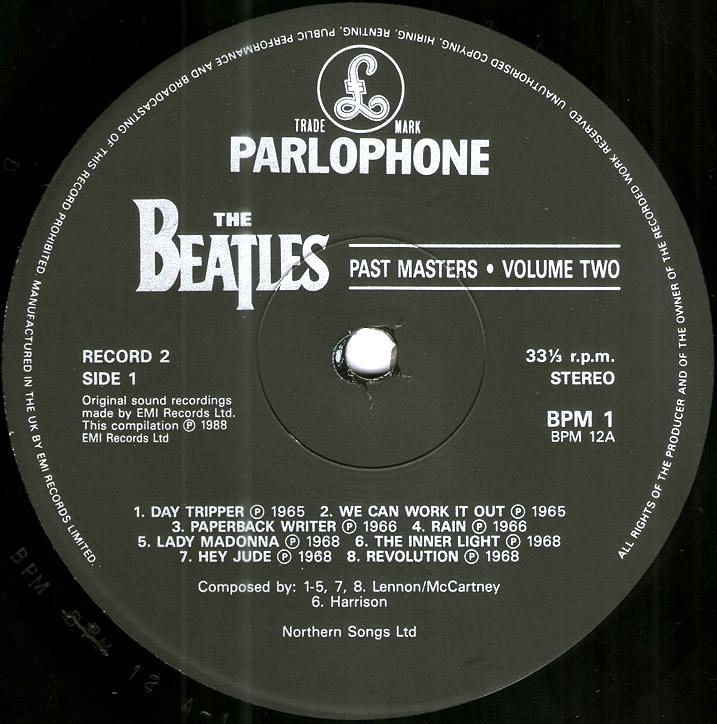
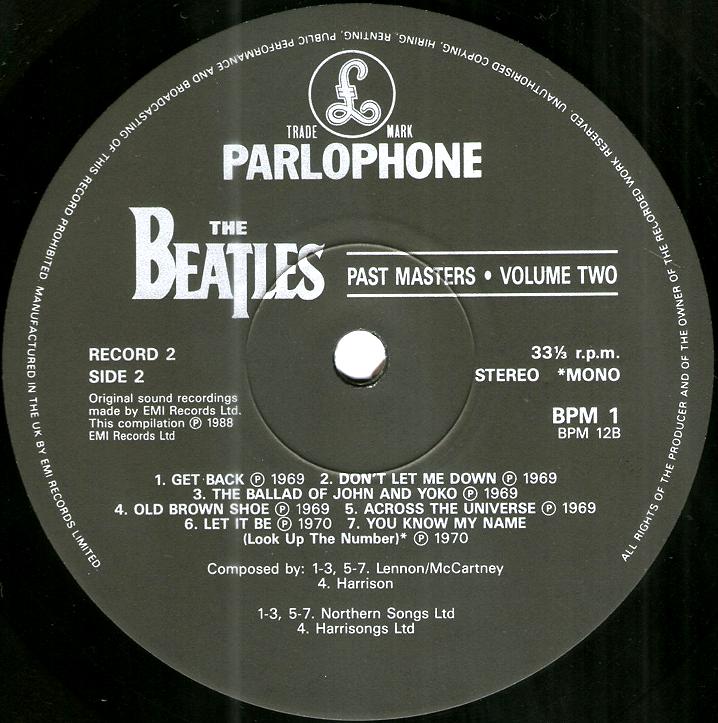
3. Third pressing, early 2000s. The gatefold outer sleeves have the Apple logo on the back side. Records are housed in white plain paper inner sleeves. This edition is characterized by wide grooves which are clearly visible on the labels. Black label with dark silver Parlophone logo and dark silver print. “ALL RIGHTS OF THE PRODUCER” printed at the start perimeter print. Importantly, around the 11 o’clock position in the rimtext the wording is (right to left): “UNAUTHORISED COPYING, HIRING, RENTING, PUBLIC PERFORMANCE AND BROADCASTING”. “MANUFACTURED IN THE UK BY EMI RECORDS” text at the end of the perimeter print. Matrix number variations: Record One – Side 1: BPM 11 A-02-01-1; Side 2 BPMBTM 12 A-1-1-2; Side 2 BPM
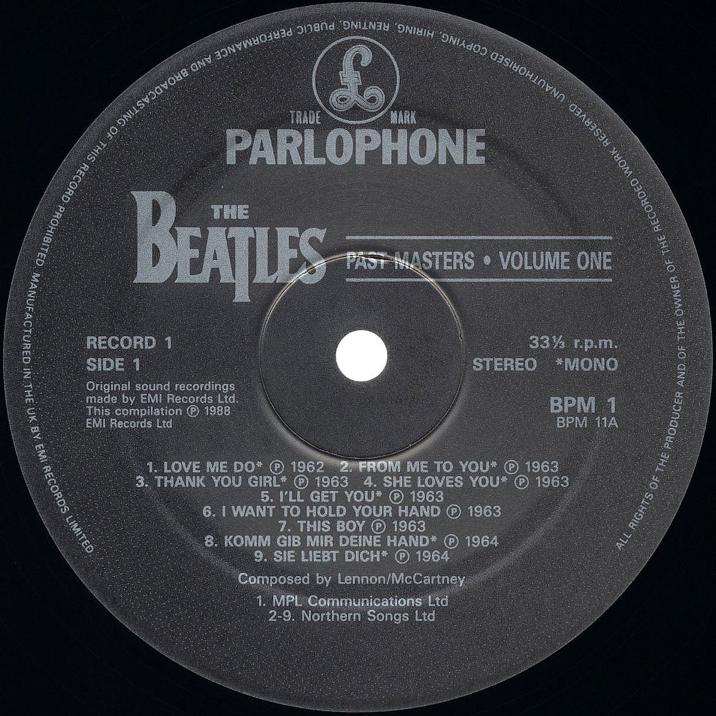
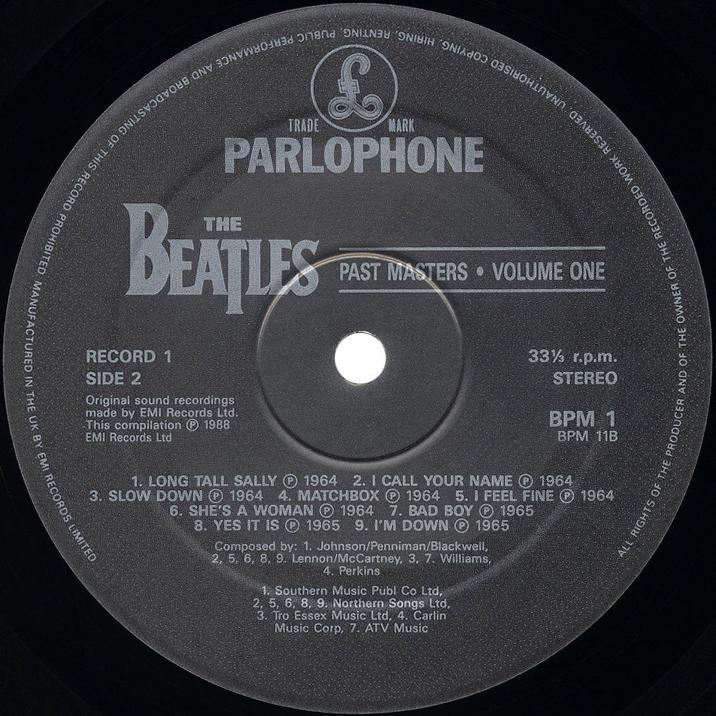
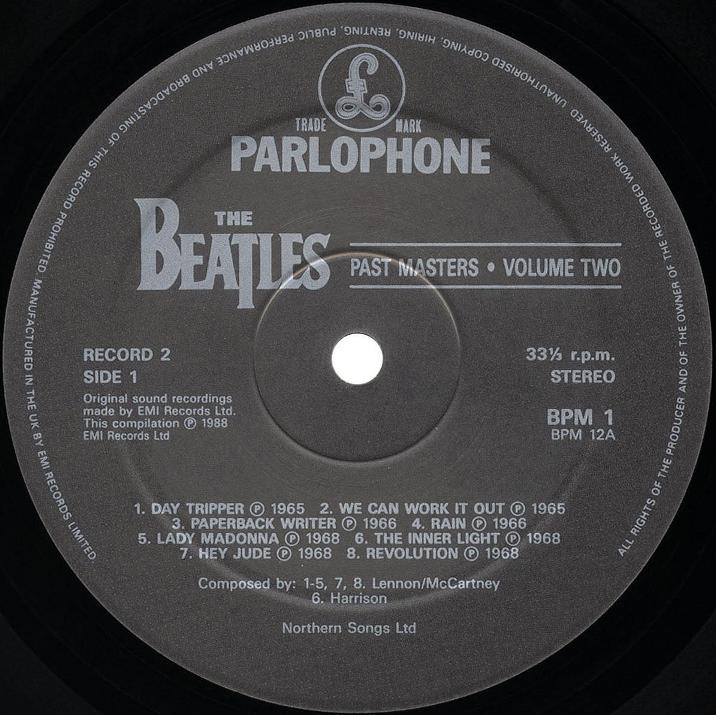
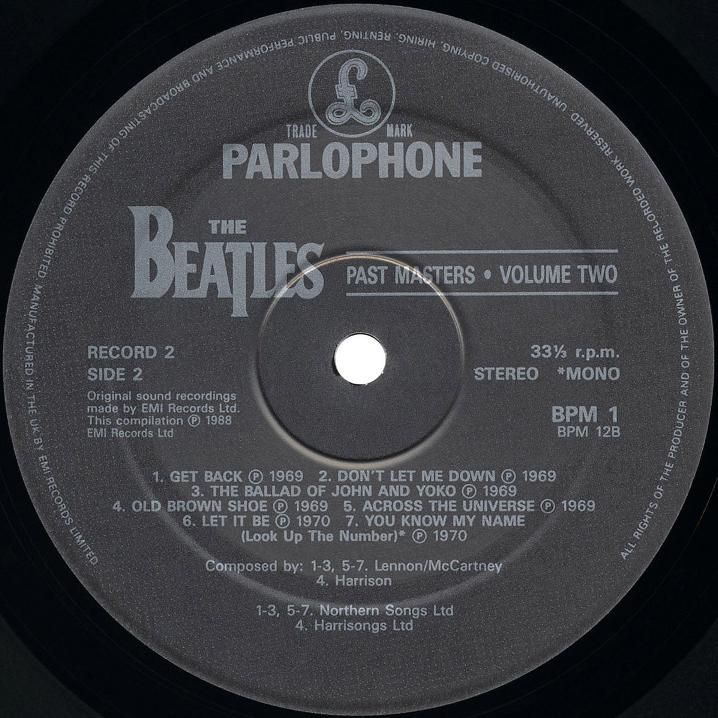
Release: September, 1982. Promotional compilation album to celebrate 50 years of Abbey Road studios. These were sent to a limited number of radio stations as part of a promotional campaign to celebrate the now legendary studios. Very limited edition. The Beatles are represented on three tracks of the 24: “She Loves You”, George’s “My Sweet Lord”, and Paul’s “Mull Of Kintyre”. Plus as composers of two others. On the remaining tracks, artists who have ever collaborated with Abbey Road studio. Not was issued on CD or cassette.
On the bottom of the dark blue sleeve appeared text “This Album Is For Promotional Use Only And Is Not Available In Any Records Store. Not For Sale.” On the back side is a brief history of the Abbey Road studio. Sleeve printed by Garrod & Lofthouse Ltd (mark PP8209 on the back).
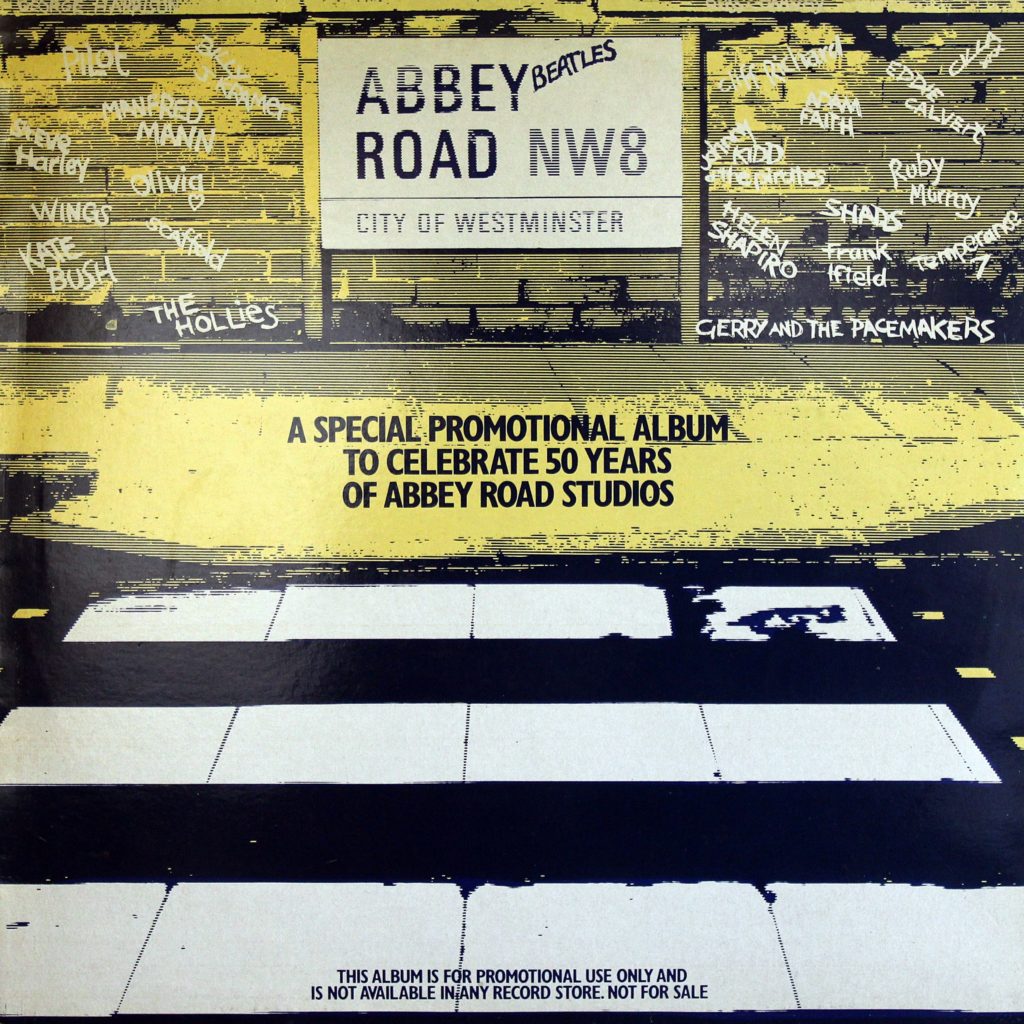
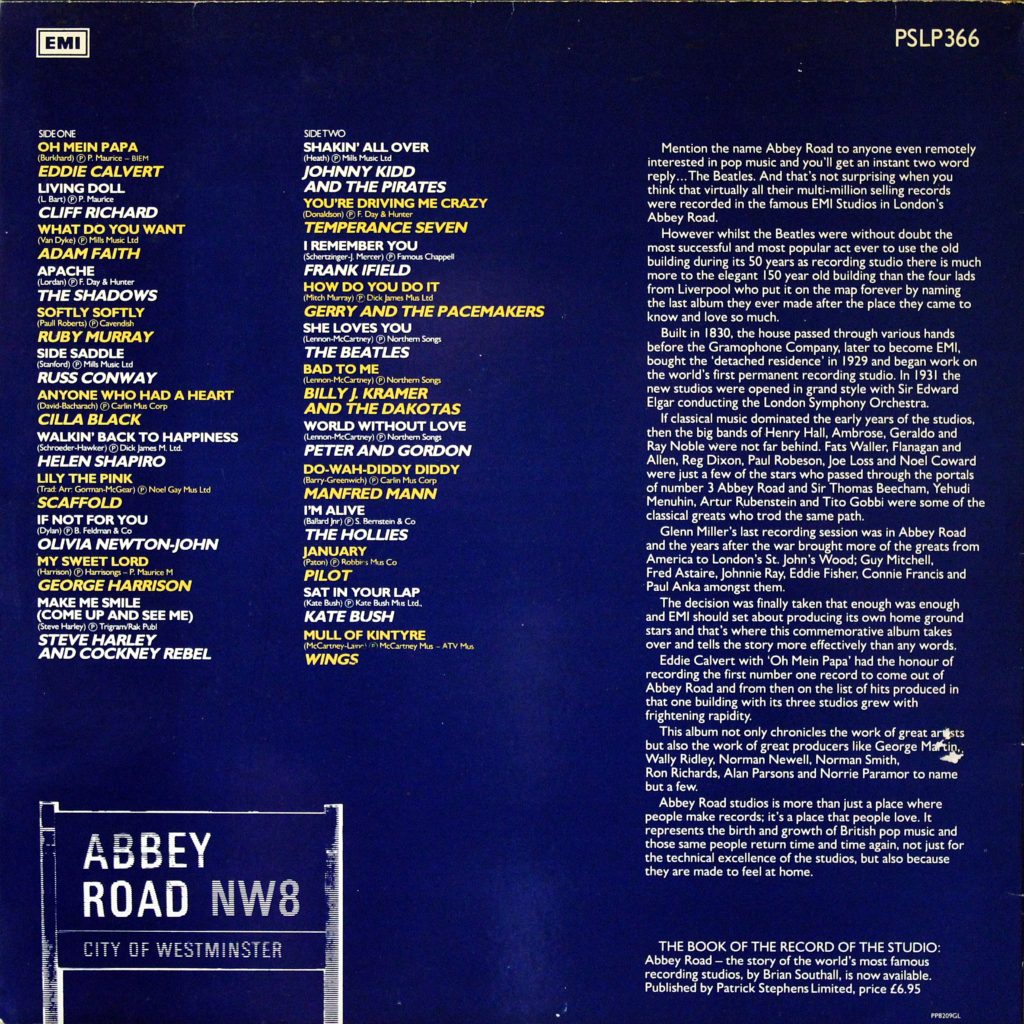
Yellow labels with black text and red perimeter text. Red EMI logos. The label states “PROMOTIONAL USE ONLY – NOT FOR SALE”. Matrix numbers: Side A: SPSLP A-1-1-1; Side B: SPSLP B-1-1-1.


Sometimes EMI had problems to press enough records to keep up with the demand. To increase production they turned to other companies to press up some copies of a particular release, however, the majority of copies were pressed by EMI themselves.
Pressed by Oriole: “I Want To Hold Your Hand”, R 5084; “Can’t Buy Me Love”, R 5114.
Oriole had a very good pressing plant that was used by several different companies, especially EMI. Oriole pressings are usually mistaken for Pye pressings. The reason for this was that Pye had several of their hits pressed by Oriole. These are distinguishing characteristics Oriole pressing:
1. No tax code is evident in the push-out centre on either side of the disc.
2. The push-out centre has a rough texture to it.
3. There is one small ridge that’s approximately 0.5mm in from the edge of the push-out centre.
4. The gap between the push-out centre and the body of the disc is approximately 2.5mm wide.
5. The tax code can be found stamped into the deadwax at the 9 o’clock position.
6. The mother plate number is pressed directly underneath the tax code at the 9 o’clock position.
7. The matrix number is stamped at the 6 o’clock position in the deadwax.
8. There are no stramper code letters stamped into the deadwax at the 3 o’clock position.
9. The dinking around the edge of the label is twice the size of the EMI press at 2mm tall. The vinyl for these pressings is thicker and heavier than EMI or Decca pressings.
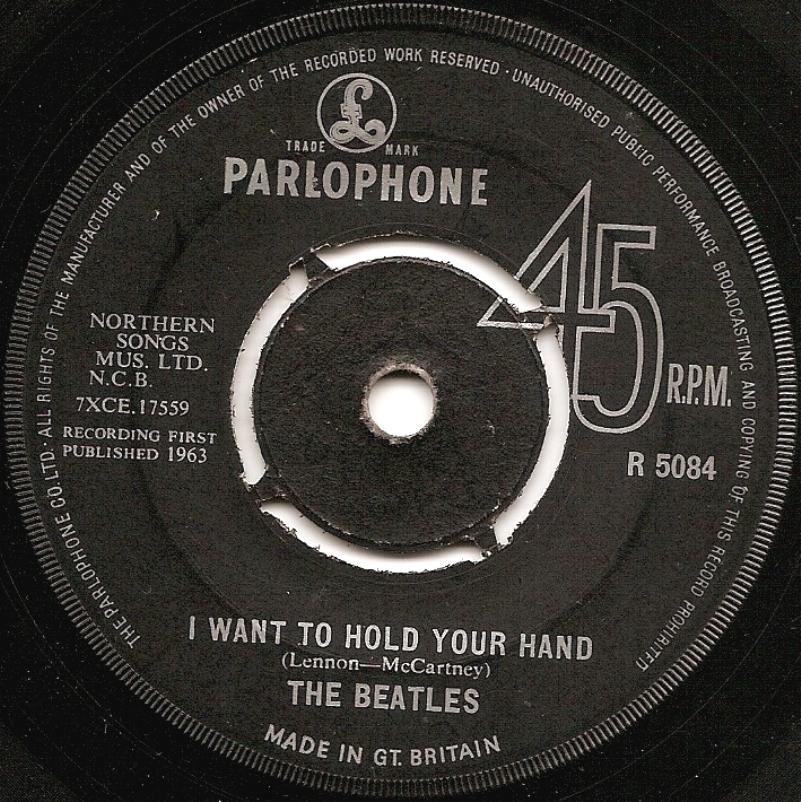
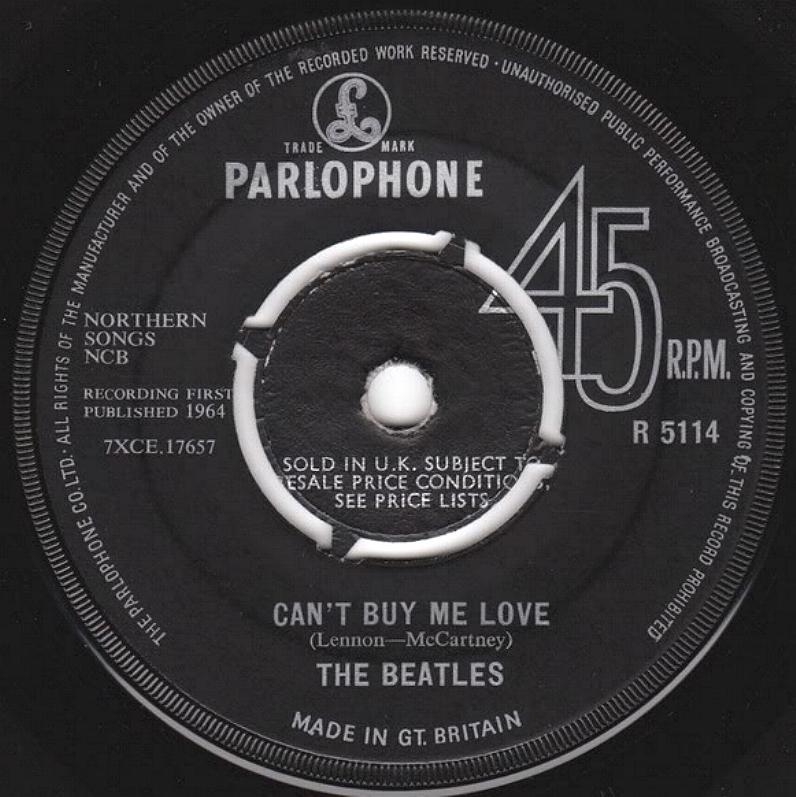
Pressed by CBS / Oriole: “I Feel Fine”, R 5200; “Hey Jude”, R 5722 (see Apple singles).
The Oriole record company had two record pressing factories, one situated in Aston Clinton and the other in Colnbrook. It lasted until 21 September 1964, when it was bought by CBS, parent of the American Columbia Records, who were looking to set up their own manufacturing facility in the UK. The result was CBS Records, and with its coming the Oriole label would be phased out. The company was officially renamed CBS Records in 1965. These are its distinguishing characteristics:
1. There is no tax code around the centre hole on either side of the disc.
2. The ridge is approximately 12.5mm out from the centre hole.
3. The gap between the push-out center and the body of the disc is approximately 2.5mm.
4. There is an outer ring on the very edge of the label (which, as a whole, is textured) that runs from the edge to just 2-3mm in. This is the only smooth part of the label. This outer ring has been highlighted in the close-up underneath.
5. The tax code can be found at the 12 o;clock position.
6. The mother plate number (either single or double figured) is at the 9 o’clock position.
7. There are no stamper code letters stamped into the deadwax at the 3 o’clock position.
8. The matrix number is stamped at the 6 o’clock position in the deadwax.
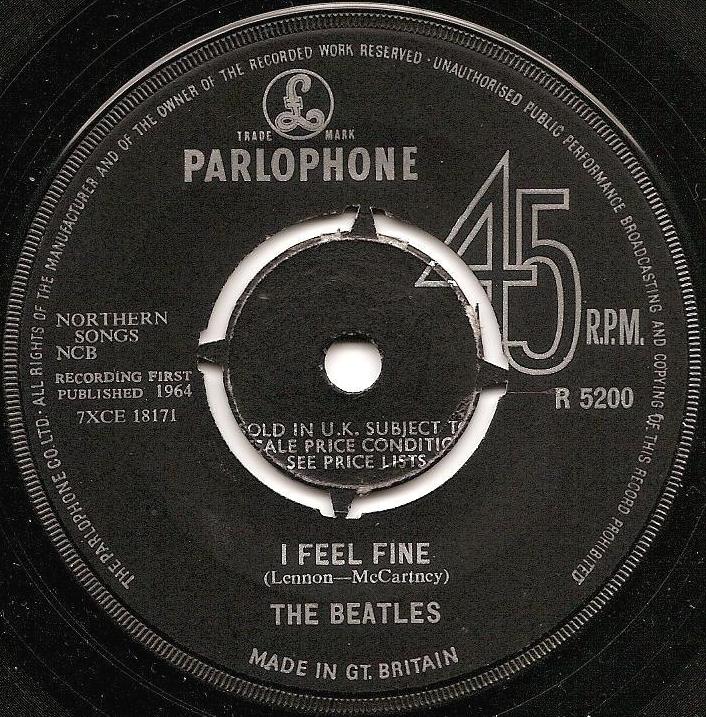
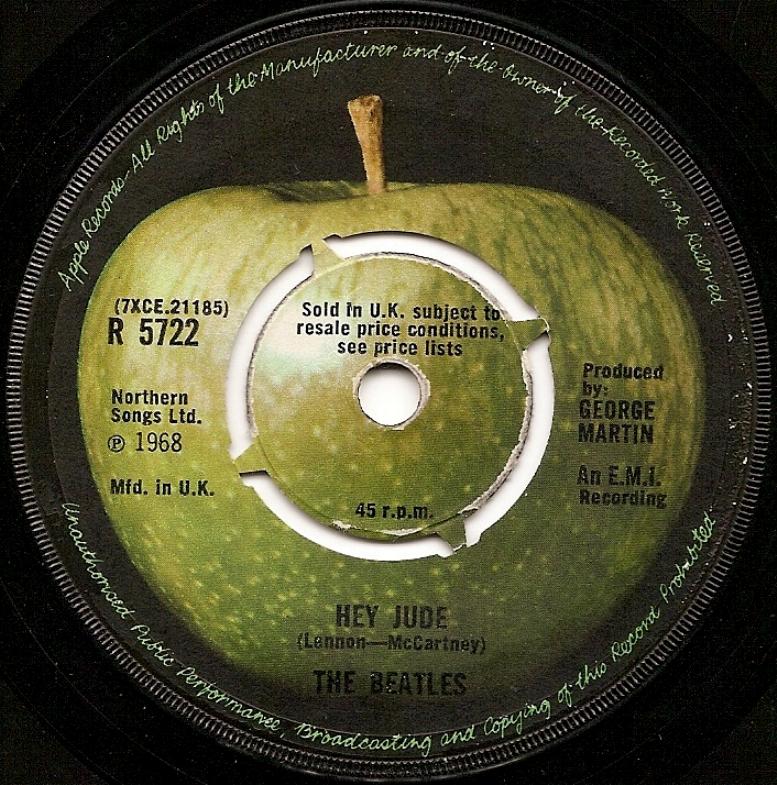
Pressed by Decca: “She Loves You”, R 5055; “I Want To Hold Your Hand”, R 5084; “I Feel Fine”, R 5200; “Help”, R 5305; “Hello Goodbye”, R 5655; “Hey Jude”, R 5722 (see Apple singles).
Decca did many contract pressings during the 60s, mainly for EMI. Typical of the Decca single is the larger space between the center and the rest of the label compared to an EMI pressing. The pressing ring of the center is also smaller and deeper on Decca pressing compared to an EMI pressing. These are distinguishing characteristics Decca:
1. No tax code is evident in the push-out centre on either side of the disc.
2. The ridge is approximately 2.5mm in from the edge of the push-out centre, or 10mm from the center hole.
3. There is a second lighter ridge that is approximately 0.5mm in from the edge of the push-out centre.
4. The gap between the push-out centre and the body of the disc is approximately 2.5mm wide.
5. The tax code on every Decca contract pressing can be found at the 12 o’clock position. “I Want To Hold Your Hand” however has the tax code pressed at the 9 o’clock position.
6. The mother plate number (either single or double figured) is pressed directly underneath the tax code at the 9 o’clock position. However, one or two very rare Decca presses have been discovered that omit this number.
7. The contract pressings did NOT utilise the BUCKINGHAM stamper codes, so there are no such letters at the 3 o’clock position.
8. The matrix number can be found at the 6 o’clock position.
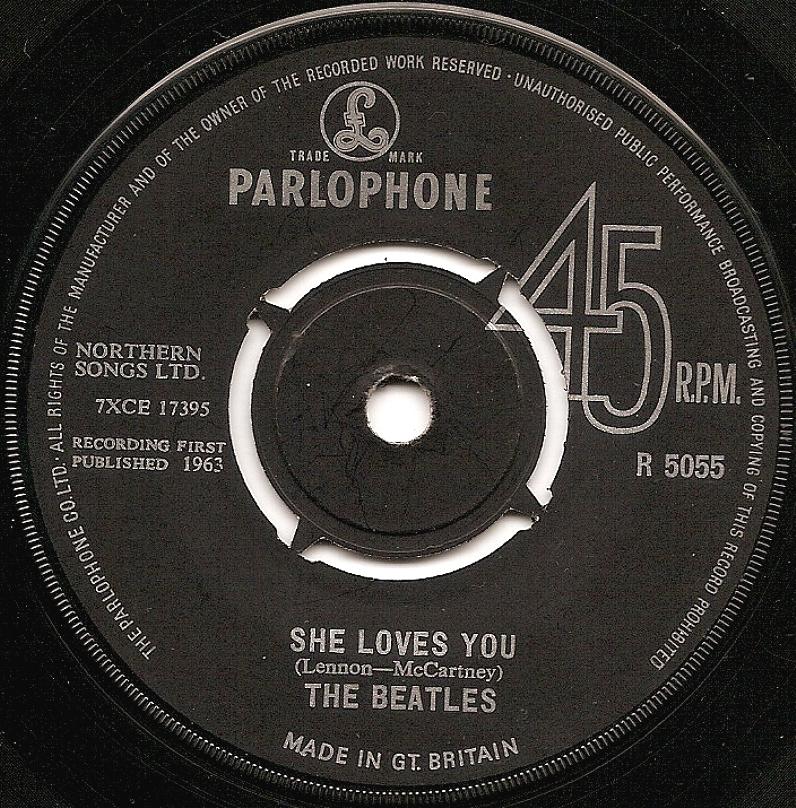
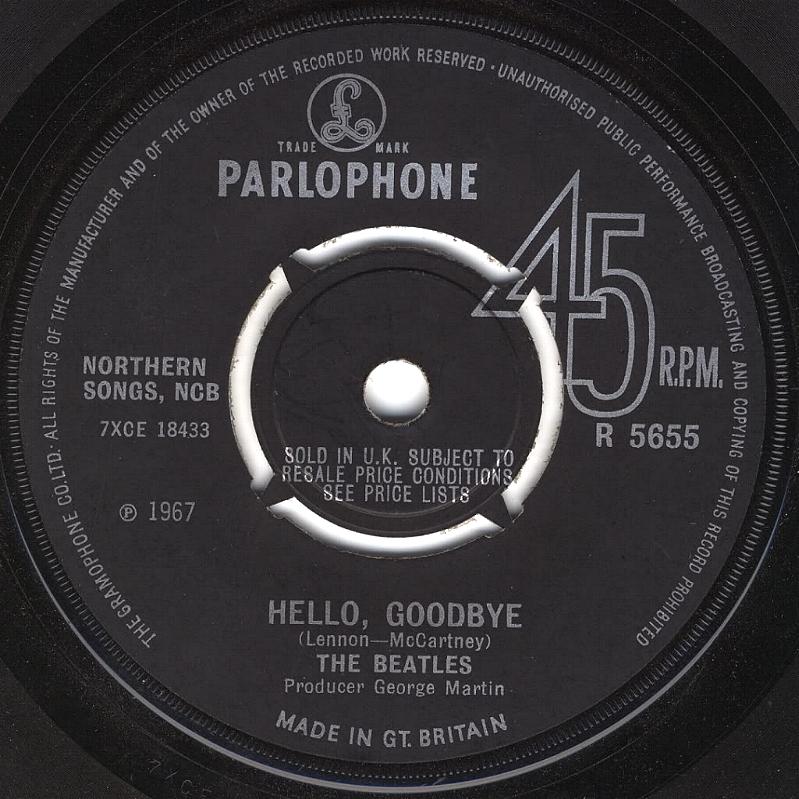
Pressed by Philips: “Hey Jude”, R 5722 (see Apple singles).
Philips did a lot of contract pressings including almost all records released by CBS before 1965. Records with push-out centers pressed by Philips are very ease to recognise because of the centers with three “spokes. These are its distinguishing characteristics:
1. There is no tax code is evident in the push-out centre on either side of the disc.
2. There is a double ridge (1mm apart) that runs around approximately 1mm in from the edge of the pushout centre. It’s 11mm out from the centre hole and approximately 28mm in from the edge of the label.
3. The gap between the push-out centre and the body of the disc is approximately 2.5mm.
4. The tax code can be found at the 12 o’clock position.
5. The mother plate number (either single or double figured) can be found at the 9 o’clock position.
6. There are no stamper code letters stamped into the deadwax at the 3 o’clock position.
7. The matrix number can be found at the 6 o’clock position.
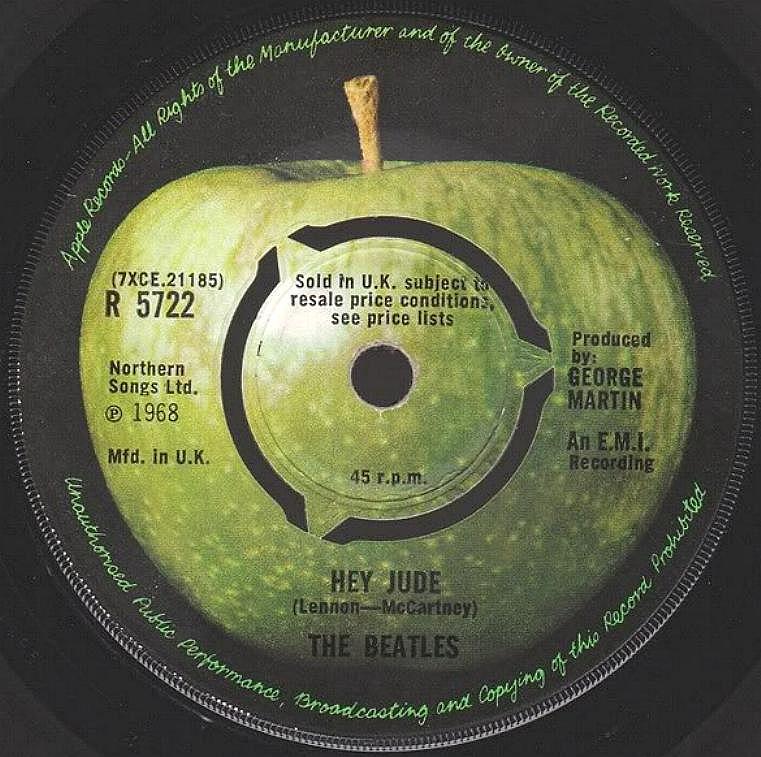
Pressed by Pye: “Hey Jude”, R 5722 (see Apple singles).
Pye probably had a limited capacity to press records, because there are a lot of contract-pressed Pye records and almost no records contract-pressed by them. However, one of the reasons why so few contract pressings by Pye have been found could be because of the similarity to Decca pressings. These are its distinguishing characteristics:
1. There is no tax code around the centre hole on either side of the disc.
2. The ridge is approximately 2.5mm in from the edge of the push-out centre or about 10mm out from the center hole.
3. The secondary ridge runs right on the very edge next to the triangular centre attachments. You can only see a second ridge at the base of these triangular shapes and *extremely* flush against the edge gap, whereas on the Decca discs this ridge is clearly visible around the extreme edge rim of the pushout section. This is consistent with all Decca and Pye discs.
4. The gap between the push-out centre and the main body of the disc is approximately 2.25mm.
5. The tax code can be found at the 12 o’clock position.
6. The mother plate number (either single or double figured) is at the 9 o’clock position.
7. A hand-etched letter has been scratched in at the 3 o’clock position. This does NOT appear on the Decca contract pressings.
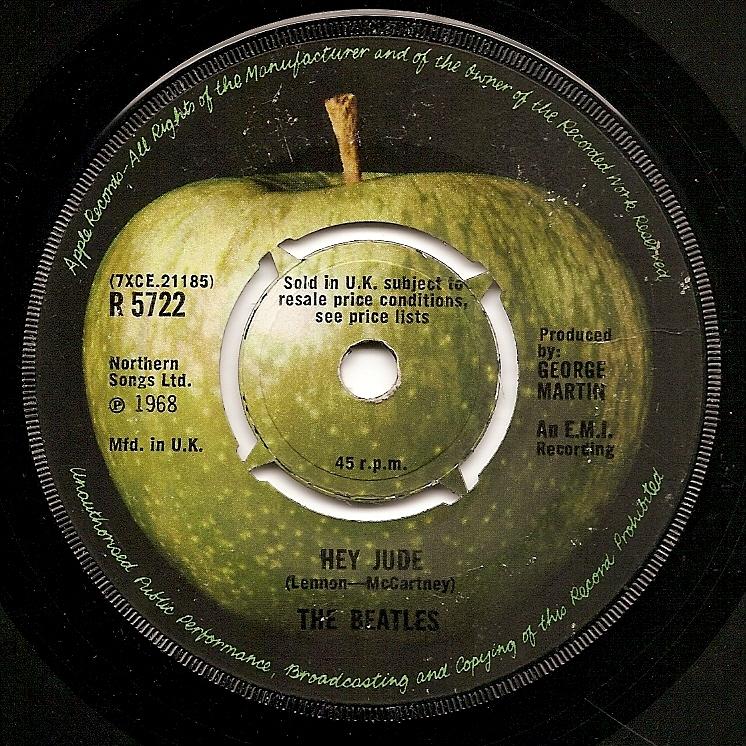
P.S. All EMI singles with solid centers pressed before 1966 are contract pressings.












































 RDF URL
RDF URL